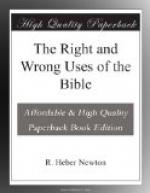The historical method is the true clue to the interpretation of a book. To know it aright we must know the age in which it was produced. This is the method by which such surprising light has been shed on many great works. Who that has read Taine’s graphic portraiture of the Elizabethan age can fail ever thereafter to see Shakespeare stand forth vividly? What can we make of Dante without some knowledge of Italy in the thirteenth century? What new life is given to Milton’s Samson after we have seen the blind old poet of the fallen Protectorate in his dreary home! How can we rightly estimate Rousseau’s writings unless we know somewhat of the artificial and luxurious age to which they came as a call back to nature? Taken out of their true surroundings these writings lose their force and meaning.
In the same way we need to find the historical place of a Biblical writing, and to read it in the light of its relation to the period.
The traditional view of Deuteronomy made it the last of the writings of Moses, a Farewell Address of the Father of his Country; reciting to the nation he had founded the story of its deliverance, repeating the laws established for its welfare, and warning it against the dangers awaiting it in the future. Such a view was attended with many difficulties, not insuperable, however, to the critical knowledge of earlier generations. Its real place in the history of Israel appears to have been found of late.
The Prophetic Reformation of Religion, begun in the eighth century before Christ, by the group of noble men of whom Isaiah was the most conspicuous had, by the latter part of the seventh century before Christ, become ripe for an organization of the institutions of religion. Jeremiah was the central figure in this second period of the prophetic movement. Upon the throne of Judah at that time was the good young king, Josiah—the Edward the Sixth of Israel—in whom the hopes of the reformers centred. About the year 625 B.C. occurred an event that decided the future of religion in Judah; described in the twenty-second chapter of the second book of Kings. The high-priest sent to the young king, saying:
I have found the book of the law in the house of the Lord.
This book of the law of Moses, according to tradition, had been lost; had been lost so long that its provisions had dropped into disuse, into oblivion; an oblivion so complete that the nation’s religion ignored and violated the whole system of that law; had been lost so long and so thoroughly that the very existence of such a law had passed from the memory of man.
This was the book that Hilkiah claimed to have re-discovered in the temple archives. It was at once read to the excited king. It made a profound impression upon him by its revelation of the apostasy in which the nation was living, and by its solemn threatenings upon such apostasy.
It came to pass that when the king
had heard the words of the book of
the law, that he rent his clothes.




